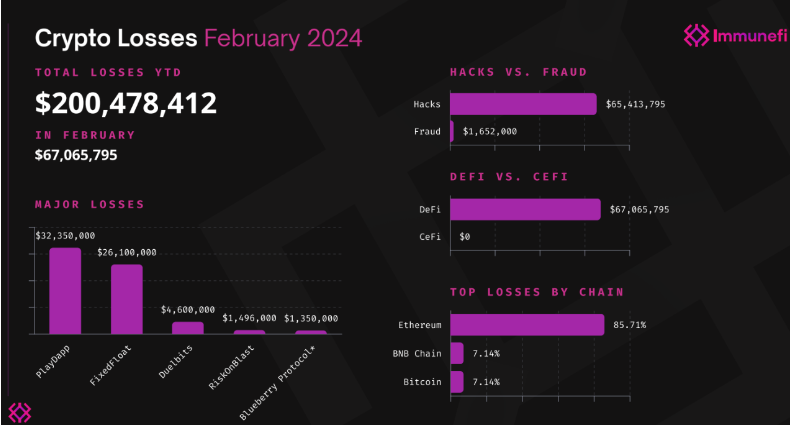ARTICLE AD BOX

Cryptocurrency thefts and fraudulent activities surged in 2024, with over $200 million lost in just two months, marking a 15.4% increase compared to the same period in 2023, according to recent findings by blockchain security firm Immunefi.
Targets and Tactics: Understanding the Landscape
The Ethereum blockchain emerged as the primary target for hackers, with approximately 85% of the total value lost in February attributed to attacks on the platform. DeFi protocols bore the brunt of these exploits, while centralized finance platforms remained unscathed throughout the month.
February alone witnessed a staggering $67 million in losses across 12 separate incidents, indicating a significant decrease from the previous month’s total of $133 million.
 Source: Immunefi
Source: ImmunefiKey Insights into Recent Hacks
The largest single loss this year occurred during a cyberattack on PlayDapp, a prominent crypto gaming platform, resulting in a loss of $32.3 million. Decentralized exchange FixedFloat followed closely, falling victim to a theft totalling $26.1 million.
 Source: Immunefi
Source: ImmunefiEthereum Dominance and Emerging Threats
Ethereum bore the brunt of the attacks, facing 12 individual incidents that accounted for the majority of losses in 2024. Binance’s BNB Chain and the Bitcoin network also experienced targeted attacks, albeit on a smaller scale.
The Rising Concern of Cryptocurrency Exploits
The surge in cryptocurrency hacks underscores a growing concern within the industry, particularly surrounding DeFi applications. With exploits on the rise, investors and platform users face heightened risks, necessitating robust security measures and proactive risk management strategies.
Learning from Past Incidents
Looking back at 2023, cryptocurrency-related hacks and scams amounted to a staggering $1.8 billion in losses. The notorious North Korean Lazarus Group alone was responsible for 17% of these illicit activities.
Addressing the Growing Threat
In 2023, notable attacks targeted platforms like Mixin Network, Euler Finance, and Multichain, resulting in losses exceeding hundreds of millions of dollars. These incidents serve as stark reminders of the importance of comprehensive security protocols and ongoing vigilance in safeguarding digital assets.
.png)
 8 months ago
13
8 months ago
13








 English (US)
English (US)